Marketing Report: Techniques, Strategies, and Market Analysis
VerifiedAdded on 2020/07/22
|9
|2759
|54
Report
AI Summary
This report provides a comprehensive overview of marketing principles and practices, focusing on the application of various techniques and strategies within the retail industry. The report begins with an introduction to marketing, emphasizing its role in creating, communicating, and delivering value to customers. It then delves into specific marketing techniques, such as Ansoff's Matrix, branding, and market penetration, used by companies like Tesco and John Lewis. The report also addresses the limitations and constraints of marketing, including legal and ethical considerations such as the Data Protection Act and sales of goods act. Furthermore, the report examines the contribution of marketing research to the development of marketing plans, including primary and secondary research methods, and the utilization of data for effective marketing planning. The report also covers customer segmentation, including geographic, demographic, psychographic, and behavioral segmentation, and concludes with a discussion of the marketing mix (4Ps) for a new product or service. Overall, the report offers valuable insights into the multifaceted nature of marketing and its practical application in real-world business scenarios.
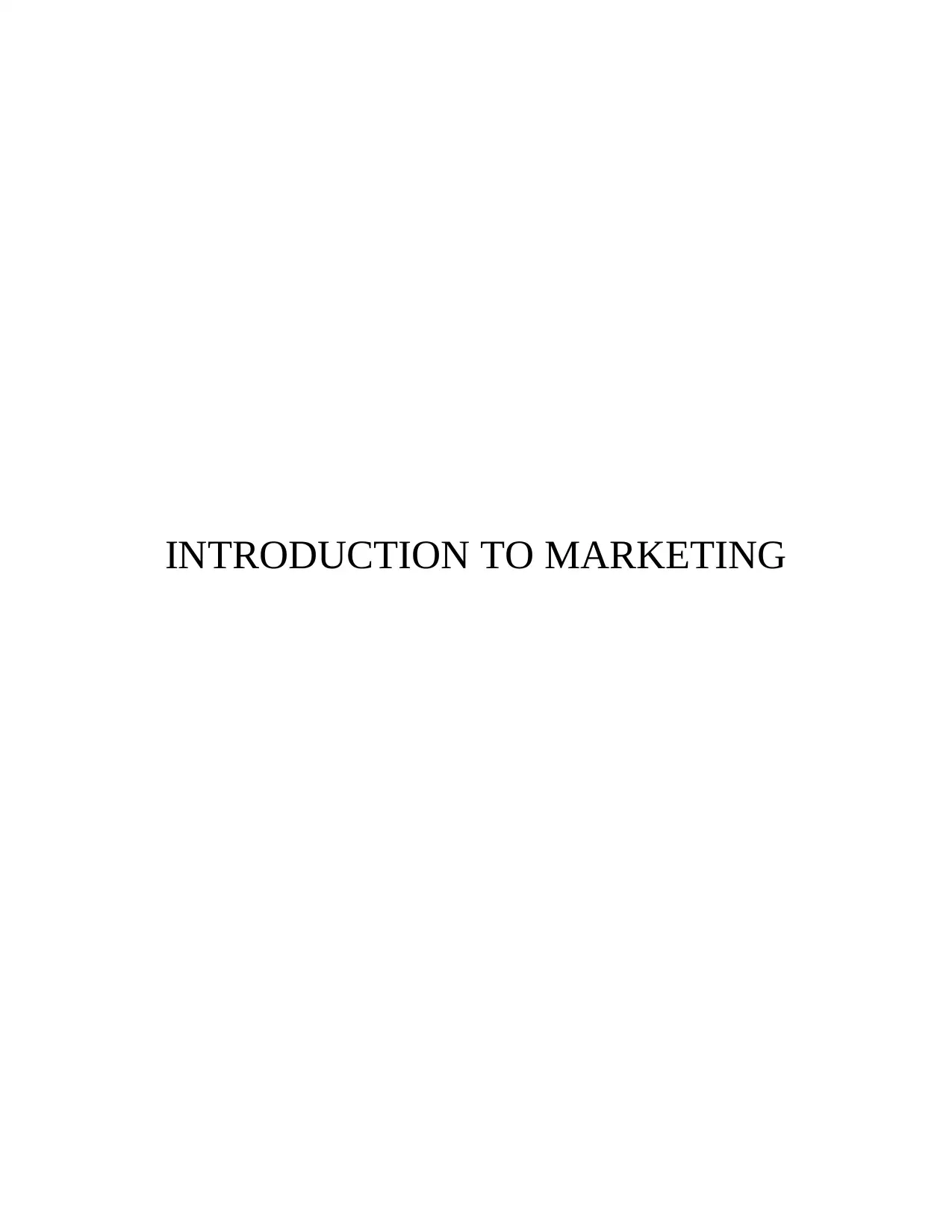
INTRODUCTION TO MARKETING
Paraphrase This Document
Need a fresh take? Get an instant paraphrase of this document with our AI Paraphraser
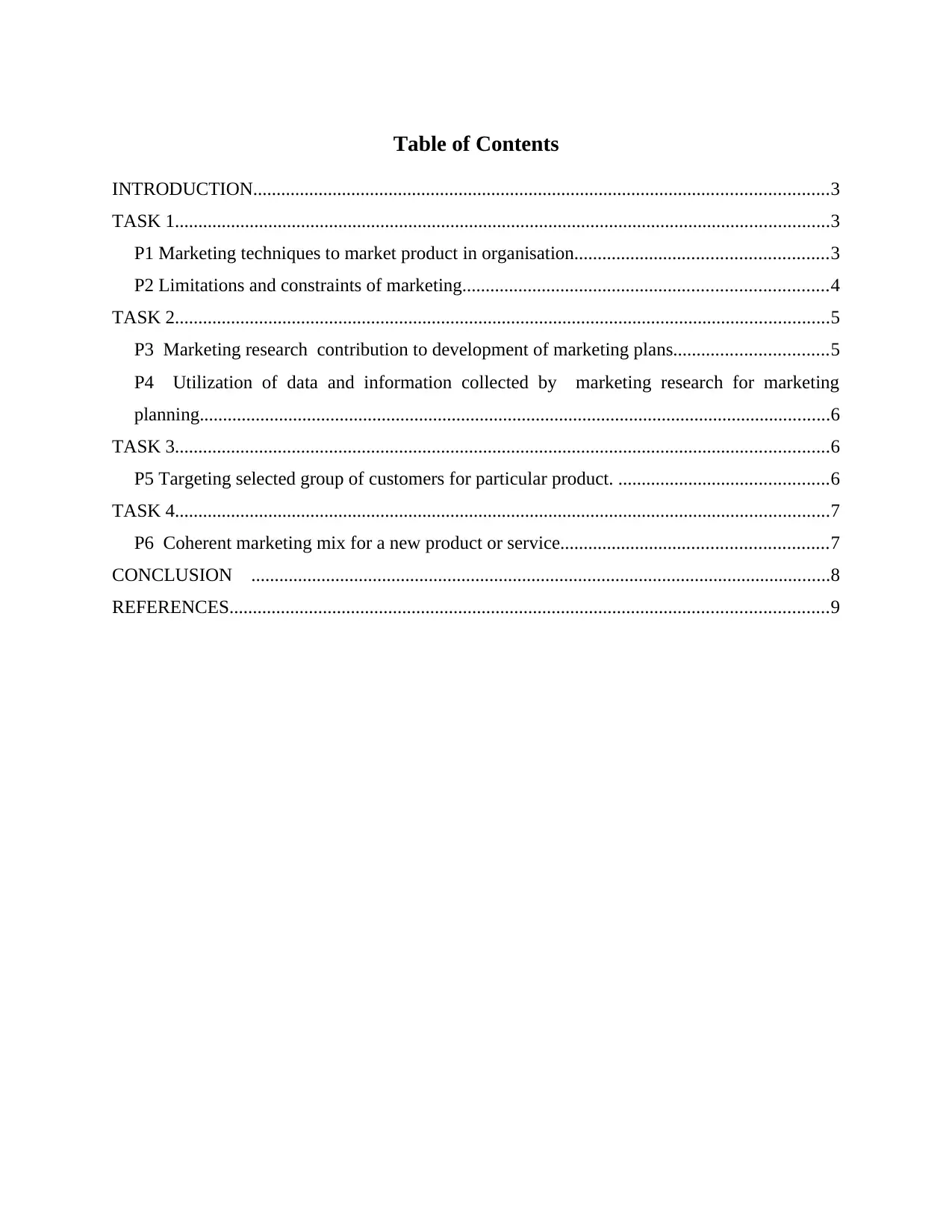
Table of Contents
INTRODUCTION...........................................................................................................................3
TASK 1............................................................................................................................................3
P1 Marketing techniques to market product in organisation......................................................3
P2 Limitations and constraints of marketing..............................................................................4
TASK 2............................................................................................................................................5
P3 Marketing research contribution to development of marketing plans.................................5
P4 Utilization of data and information collected by marketing research for marketing
planning.......................................................................................................................................6
TASK 3............................................................................................................................................6
P5 Targeting selected group of customers for particular product. .............................................6
TASK 4............................................................................................................................................7
P6 Coherent marketing mix for a new product or service.........................................................7
CONCLUSION ............................................................................................................................8
REFERENCES................................................................................................................................9
INTRODUCTION...........................................................................................................................3
TASK 1............................................................................................................................................3
P1 Marketing techniques to market product in organisation......................................................3
P2 Limitations and constraints of marketing..............................................................................4
TASK 2............................................................................................................................................5
P3 Marketing research contribution to development of marketing plans.................................5
P4 Utilization of data and information collected by marketing research for marketing
planning.......................................................................................................................................6
TASK 3............................................................................................................................................6
P5 Targeting selected group of customers for particular product. .............................................6
TASK 4............................................................................................................................................7
P6 Coherent marketing mix for a new product or service.........................................................7
CONCLUSION ............................................................................................................................8
REFERENCES................................................................................................................................9
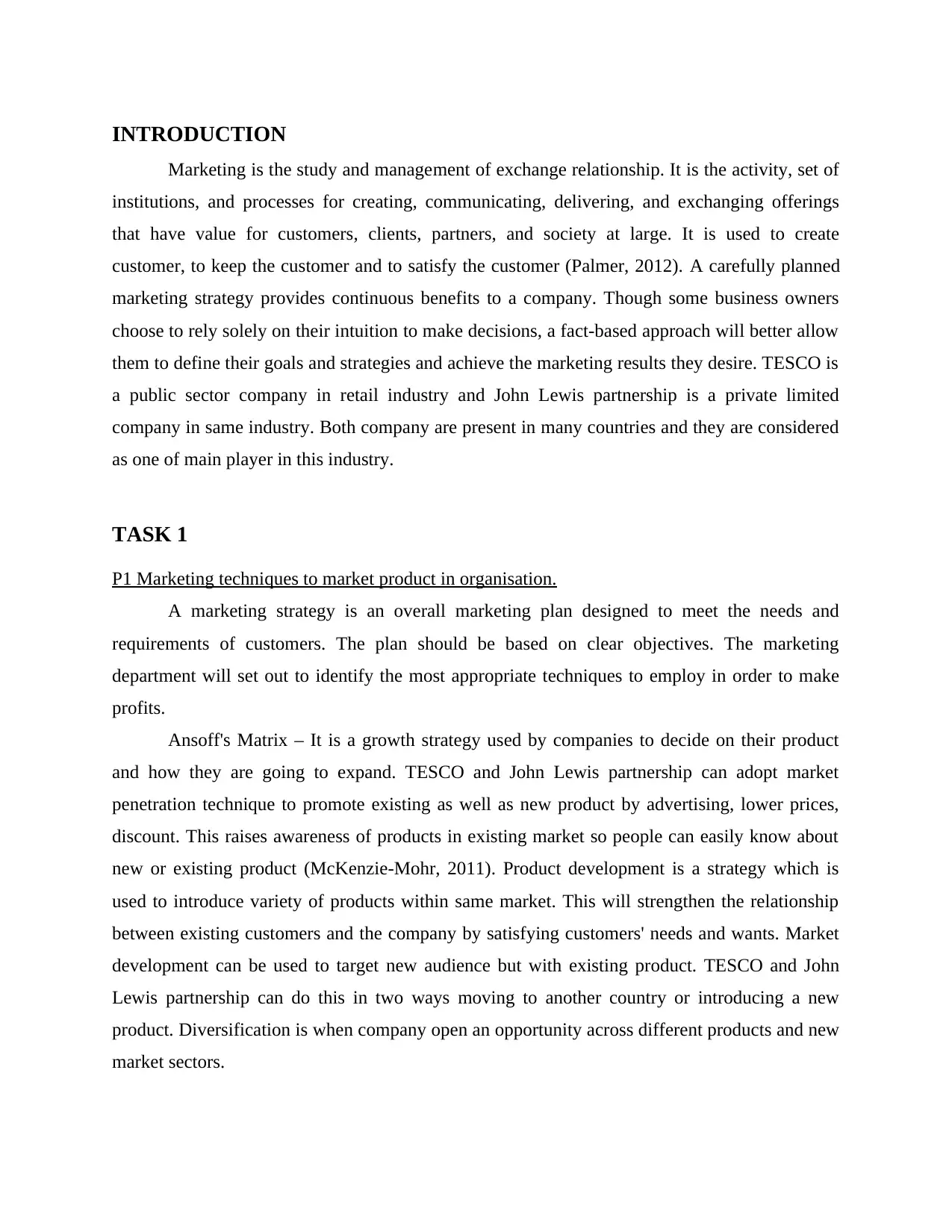
INTRODUCTION
Marketing is the study and management of exchange relationship. It is the activity, set of
institutions, and processes for creating, communicating, delivering, and exchanging offerings
that have value for customers, clients, partners, and society at large. It is used to create
customer, to keep the customer and to satisfy the customer (Palmer, 2012). A carefully planned
marketing strategy provides continuous benefits to a company. Though some business owners
choose to rely solely on their intuition to make decisions, a fact-based approach will better allow
them to define their goals and strategies and achieve the marketing results they desire. TESCO is
a public sector company in retail industry and John Lewis partnership is a private limited
company in same industry. Both company are present in many countries and they are considered
as one of main player in this industry.
TASK 1
P1 Marketing techniques to market product in organisation.
A marketing strategy is an overall marketing plan designed to meet the needs and
requirements of customers. The plan should be based on clear objectives. The marketing
department will set out to identify the most appropriate techniques to employ in order to make
profits.
Ansoff's Matrix – It is a growth strategy used by companies to decide on their product
and how they are going to expand. TESCO and John Lewis partnership can adopt market
penetration technique to promote existing as well as new product by advertising, lower prices,
discount. This raises awareness of products in existing market so people can easily know about
new or existing product (McKenzie-Mohr, 2011). Product development is a strategy which is
used to introduce variety of products within same market. This will strengthen the relationship
between existing customers and the company by satisfying customers' needs and wants. Market
development can be used to target new audience but with existing product. TESCO and John
Lewis partnership can do this in two ways moving to another country or introducing a new
product. Diversification is when company open an opportunity across different products and new
market sectors.
Marketing is the study and management of exchange relationship. It is the activity, set of
institutions, and processes for creating, communicating, delivering, and exchanging offerings
that have value for customers, clients, partners, and society at large. It is used to create
customer, to keep the customer and to satisfy the customer (Palmer, 2012). A carefully planned
marketing strategy provides continuous benefits to a company. Though some business owners
choose to rely solely on their intuition to make decisions, a fact-based approach will better allow
them to define their goals and strategies and achieve the marketing results they desire. TESCO is
a public sector company in retail industry and John Lewis partnership is a private limited
company in same industry. Both company are present in many countries and they are considered
as one of main player in this industry.
TASK 1
P1 Marketing techniques to market product in organisation.
A marketing strategy is an overall marketing plan designed to meet the needs and
requirements of customers. The plan should be based on clear objectives. The marketing
department will set out to identify the most appropriate techniques to employ in order to make
profits.
Ansoff's Matrix – It is a growth strategy used by companies to decide on their product
and how they are going to expand. TESCO and John Lewis partnership can adopt market
penetration technique to promote existing as well as new product by advertising, lower prices,
discount. This raises awareness of products in existing market so people can easily know about
new or existing product (McKenzie-Mohr, 2011). Product development is a strategy which is
used to introduce variety of products within same market. This will strengthen the relationship
between existing customers and the company by satisfying customers' needs and wants. Market
development can be used to target new audience but with existing product. TESCO and John
Lewis partnership can do this in two ways moving to another country or introducing a new
product. Diversification is when company open an opportunity across different products and new
market sectors.
⊘ This is a preview!⊘
Do you want full access?
Subscribe today to unlock all pages.

Trusted by 1+ million students worldwide
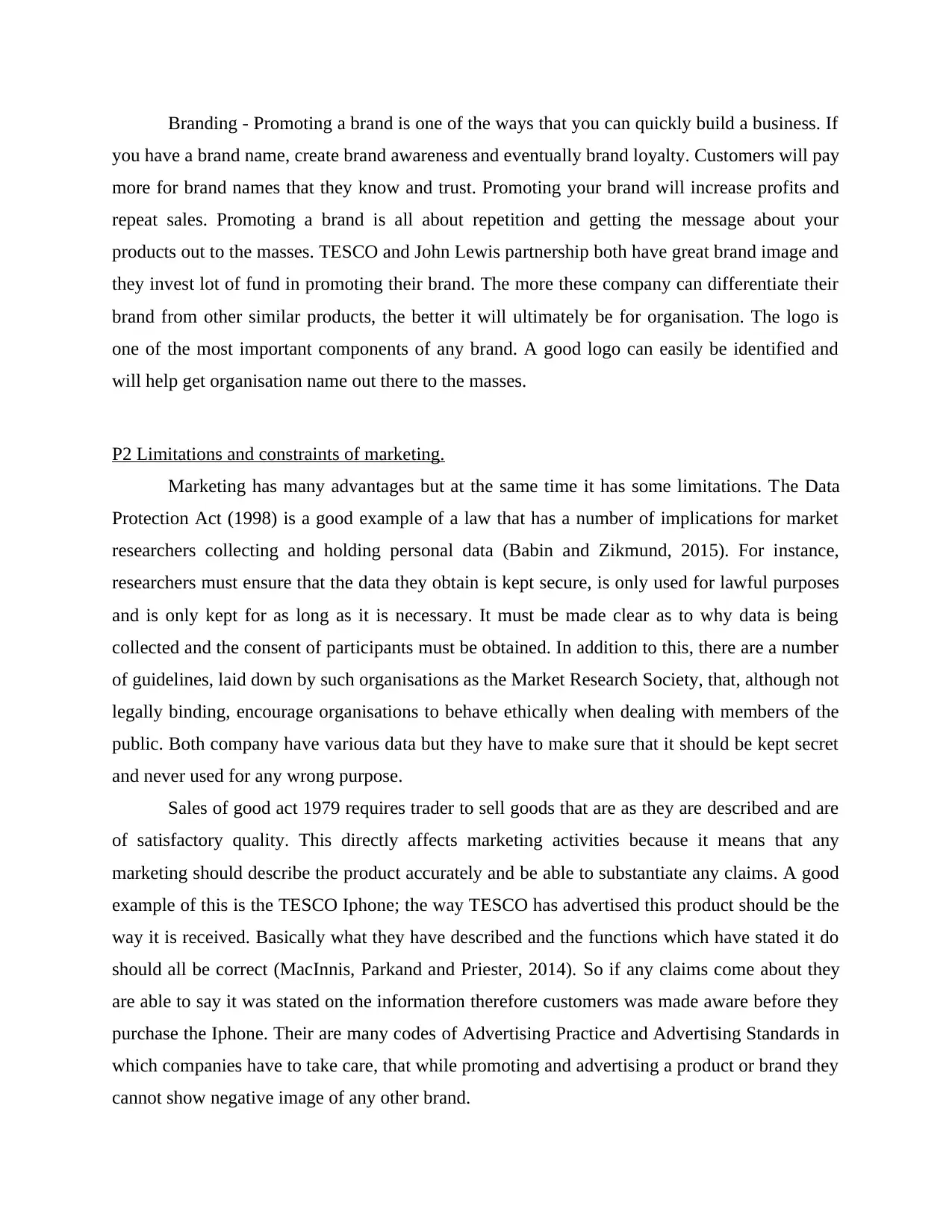
Branding - Promoting a brand is one of the ways that you can quickly build a business. If
you have a brand name, create brand awareness and eventually brand loyalty. Customers will pay
more for brand names that they know and trust. Promoting your brand will increase profits and
repeat sales. Promoting a brand is all about repetition and getting the message about your
products out to the masses. TESCO and John Lewis partnership both have great brand image and
they invest lot of fund in promoting their brand. The more these company can differentiate their
brand from other similar products, the better it will ultimately be for organisation. The logo is
one of the most important components of any brand. A good logo can easily be identified and
will help get organisation name out there to the masses.
P2 Limitations and constraints of marketing.
Marketing has many advantages but at the same time it has some limitations. The Data
Protection Act (1998) is a good example of a law that has a number of implications for market
researchers collecting and holding personal data (Babin and Zikmund, 2015). For instance,
researchers must ensure that the data they obtain is kept secure, is only used for lawful purposes
and is only kept for as long as it is necessary. It must be made clear as to why data is being
collected and the consent of participants must be obtained. In addition to this, there are a number
of guidelines, laid down by such organisations as the Market Research Society, that, although not
legally binding, encourage organisations to behave ethically when dealing with members of the
public. Both company have various data but they have to make sure that it should be kept secret
and never used for any wrong purpose.
Sales of good act 1979 requires trader to sell goods that are as they are described and are
of satisfactory quality. This directly affects marketing activities because it means that any
marketing should describe the product accurately and be able to substantiate any claims. A good
example of this is the TESCO Iphone; the way TESCO has advertised this product should be the
way it is received. Basically what they have described and the functions which have stated it do
should all be correct (MacInnis, Parkand and Priester, 2014). So if any claims come about they
are able to say it was stated on the information therefore customers was made aware before they
purchase the Iphone. Their are many codes of Advertising Practice and Advertising Standards in
which companies have to take care, that while promoting and advertising a product or brand they
cannot show negative image of any other brand.
you have a brand name, create brand awareness and eventually brand loyalty. Customers will pay
more for brand names that they know and trust. Promoting your brand will increase profits and
repeat sales. Promoting a brand is all about repetition and getting the message about your
products out to the masses. TESCO and John Lewis partnership both have great brand image and
they invest lot of fund in promoting their brand. The more these company can differentiate their
brand from other similar products, the better it will ultimately be for organisation. The logo is
one of the most important components of any brand. A good logo can easily be identified and
will help get organisation name out there to the masses.
P2 Limitations and constraints of marketing.
Marketing has many advantages but at the same time it has some limitations. The Data
Protection Act (1998) is a good example of a law that has a number of implications for market
researchers collecting and holding personal data (Babin and Zikmund, 2015). For instance,
researchers must ensure that the data they obtain is kept secure, is only used for lawful purposes
and is only kept for as long as it is necessary. It must be made clear as to why data is being
collected and the consent of participants must be obtained. In addition to this, there are a number
of guidelines, laid down by such organisations as the Market Research Society, that, although not
legally binding, encourage organisations to behave ethically when dealing with members of the
public. Both company have various data but they have to make sure that it should be kept secret
and never used for any wrong purpose.
Sales of good act 1979 requires trader to sell goods that are as they are described and are
of satisfactory quality. This directly affects marketing activities because it means that any
marketing should describe the product accurately and be able to substantiate any claims. A good
example of this is the TESCO Iphone; the way TESCO has advertised this product should be the
way it is received. Basically what they have described and the functions which have stated it do
should all be correct (MacInnis, Parkand and Priester, 2014). So if any claims come about they
are able to say it was stated on the information therefore customers was made aware before they
purchase the Iphone. Their are many codes of Advertising Practice and Advertising Standards in
which companies have to take care, that while promoting and advertising a product or brand they
cannot show negative image of any other brand.
Paraphrase This Document
Need a fresh take? Get an instant paraphrase of this document with our AI Paraphraser
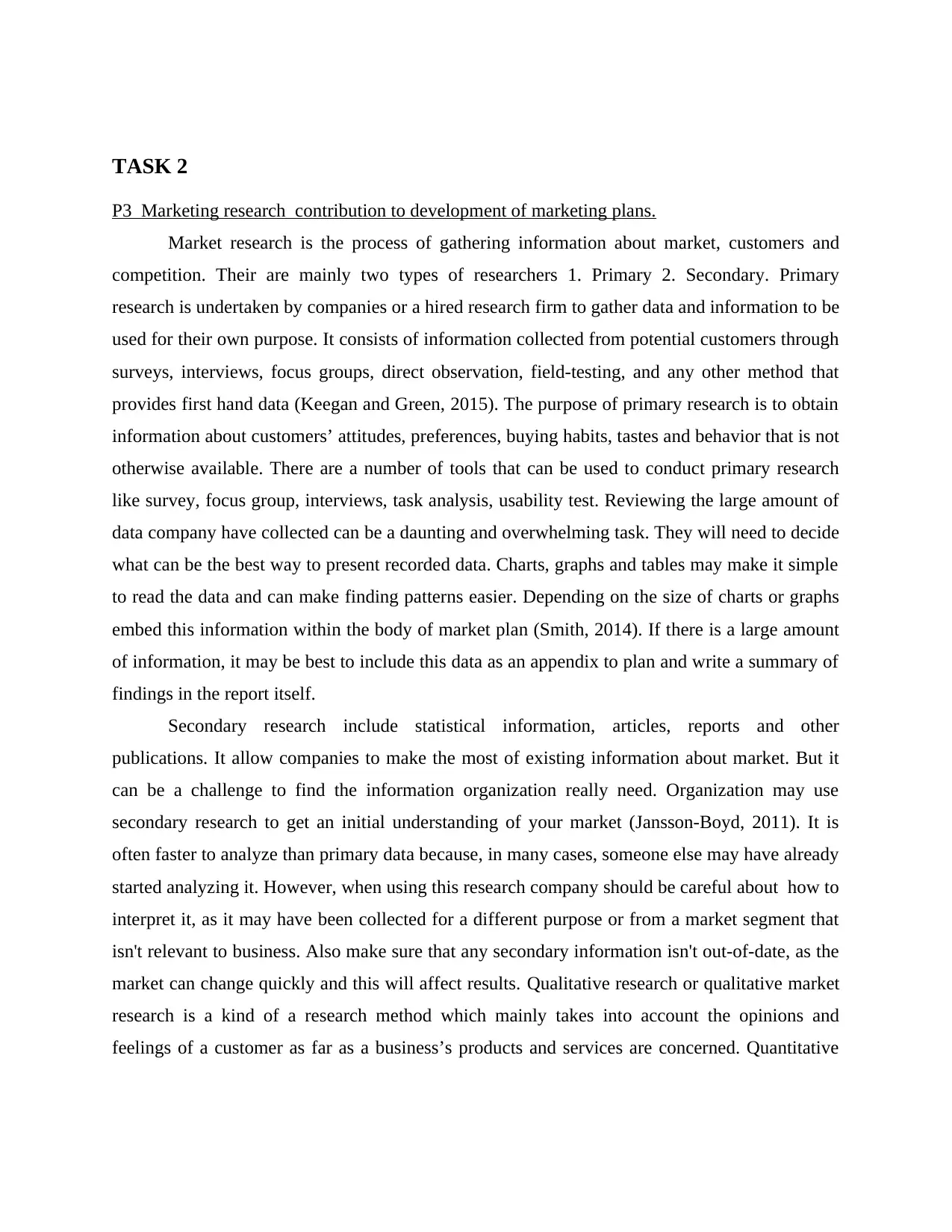
TASK 2
P3 Marketing research contribution to development of marketing plans.
Market research is the process of gathering information about market, customers and
competition. Their are mainly two types of researchers 1. Primary 2. Secondary. Primary
research is undertaken by companies or a hired research firm to gather data and information to be
used for their own purpose. It consists of information collected from potential customers through
surveys, interviews, focus groups, direct observation, field-testing, and any other method that
provides first hand data (Keegan and Green, 2015). The purpose of primary research is to obtain
information about customers’ attitudes, preferences, buying habits, tastes and behavior that is not
otherwise available. There are a number of tools that can be used to conduct primary research
like survey, focus group, interviews, task analysis, usability test. Reviewing the large amount of
data company have collected can be a daunting and overwhelming task. They will need to decide
what can be the best way to present recorded data. Charts, graphs and tables may make it simple
to read the data and can make finding patterns easier. Depending on the size of charts or graphs
embed this information within the body of market plan (Smith, 2014). If there is a large amount
of information, it may be best to include this data as an appendix to plan and write a summary of
findings in the report itself.
Secondary research include statistical information, articles, reports and other
publications. It allow companies to make the most of existing information about market. But it
can be a challenge to find the information organization really need. Organization may use
secondary research to get an initial understanding of your market (Jansson‐Boyd, 2011). It is
often faster to analyze than primary data because, in many cases, someone else may have already
started analyzing it. However, when using this research company should be careful about how to
interpret it, as it may have been collected for a different purpose or from a market segment that
isn't relevant to business. Also make sure that any secondary information isn't out-of-date, as the
market can change quickly and this will affect results. Qualitative research or qualitative market
research is a kind of a research method which mainly takes into account the opinions and
feelings of a customer as far as a business’s products and services are concerned. Quantitative
P3 Marketing research contribution to development of marketing plans.
Market research is the process of gathering information about market, customers and
competition. Their are mainly two types of researchers 1. Primary 2. Secondary. Primary
research is undertaken by companies or a hired research firm to gather data and information to be
used for their own purpose. It consists of information collected from potential customers through
surveys, interviews, focus groups, direct observation, field-testing, and any other method that
provides first hand data (Keegan and Green, 2015). The purpose of primary research is to obtain
information about customers’ attitudes, preferences, buying habits, tastes and behavior that is not
otherwise available. There are a number of tools that can be used to conduct primary research
like survey, focus group, interviews, task analysis, usability test. Reviewing the large amount of
data company have collected can be a daunting and overwhelming task. They will need to decide
what can be the best way to present recorded data. Charts, graphs and tables may make it simple
to read the data and can make finding patterns easier. Depending on the size of charts or graphs
embed this information within the body of market plan (Smith, 2014). If there is a large amount
of information, it may be best to include this data as an appendix to plan and write a summary of
findings in the report itself.
Secondary research include statistical information, articles, reports and other
publications. It allow companies to make the most of existing information about market. But it
can be a challenge to find the information organization really need. Organization may use
secondary research to get an initial understanding of your market (Jansson‐Boyd, 2011). It is
often faster to analyze than primary data because, in many cases, someone else may have already
started analyzing it. However, when using this research company should be careful about how to
interpret it, as it may have been collected for a different purpose or from a market segment that
isn't relevant to business. Also make sure that any secondary information isn't out-of-date, as the
market can change quickly and this will affect results. Qualitative research or qualitative market
research is a kind of a research method which mainly takes into account the opinions and
feelings of a customer as far as a business’s products and services are concerned. Quantitative
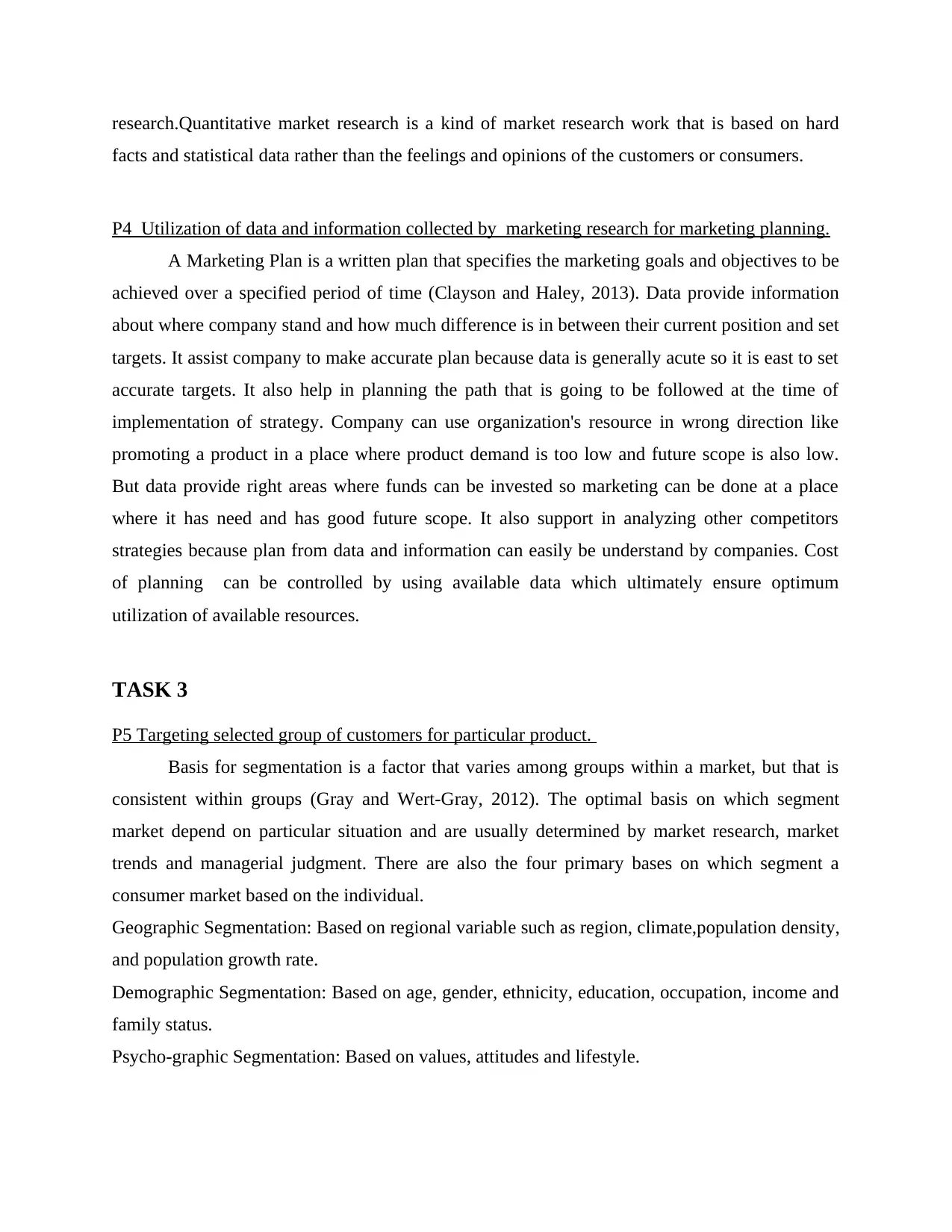
research.Quantitative market research is a kind of market research work that is based on hard
facts and statistical data rather than the feelings and opinions of the customers or consumers.
P4 Utilization of data and information collected by marketing research for marketing planning.
A Marketing Plan is a written plan that specifies the marketing goals and objectives to be
achieved over a specified period of time (Clayson and Haley, 2013). Data provide information
about where company stand and how much difference is in between their current position and set
targets. It assist company to make accurate plan because data is generally acute so it is east to set
accurate targets. It also help in planning the path that is going to be followed at the time of
implementation of strategy. Company can use organization's resource in wrong direction like
promoting a product in a place where product demand is too low and future scope is also low.
But data provide right areas where funds can be invested so marketing can be done at a place
where it has need and has good future scope. It also support in analyzing other competitors
strategies because plan from data and information can easily be understand by companies. Cost
of planning can be controlled by using available data which ultimately ensure optimum
utilization of available resources.
TASK 3
P5 Targeting selected group of customers for particular product.
Basis for segmentation is a factor that varies among groups within a market, but that is
consistent within groups (Gray and Wert‐Gray, 2012). The optimal basis on which segment
market depend on particular situation and are usually determined by market research, market
trends and managerial judgment. There are also the four primary bases on which segment a
consumer market based on the individual.
Geographic Segmentation: Based on regional variable such as region, climate,population density,
and population growth rate.
Demographic Segmentation: Based on age, gender, ethnicity, education, occupation, income and
family status.
Psycho-graphic Segmentation: Based on values, attitudes and lifestyle.
facts and statistical data rather than the feelings and opinions of the customers or consumers.
P4 Utilization of data and information collected by marketing research for marketing planning.
A Marketing Plan is a written plan that specifies the marketing goals and objectives to be
achieved over a specified period of time (Clayson and Haley, 2013). Data provide information
about where company stand and how much difference is in between their current position and set
targets. It assist company to make accurate plan because data is generally acute so it is east to set
accurate targets. It also help in planning the path that is going to be followed at the time of
implementation of strategy. Company can use organization's resource in wrong direction like
promoting a product in a place where product demand is too low and future scope is also low.
But data provide right areas where funds can be invested so marketing can be done at a place
where it has need and has good future scope. It also support in analyzing other competitors
strategies because plan from data and information can easily be understand by companies. Cost
of planning can be controlled by using available data which ultimately ensure optimum
utilization of available resources.
TASK 3
P5 Targeting selected group of customers for particular product.
Basis for segmentation is a factor that varies among groups within a market, but that is
consistent within groups (Gray and Wert‐Gray, 2012). The optimal basis on which segment
market depend on particular situation and are usually determined by market research, market
trends and managerial judgment. There are also the four primary bases on which segment a
consumer market based on the individual.
Geographic Segmentation: Based on regional variable such as region, climate,population density,
and population growth rate.
Demographic Segmentation: Based on age, gender, ethnicity, education, occupation, income and
family status.
Psycho-graphic Segmentation: Based on values, attitudes and lifestyle.
⊘ This is a preview!⊘
Do you want full access?
Subscribe today to unlock all pages.

Trusted by 1+ million students worldwide
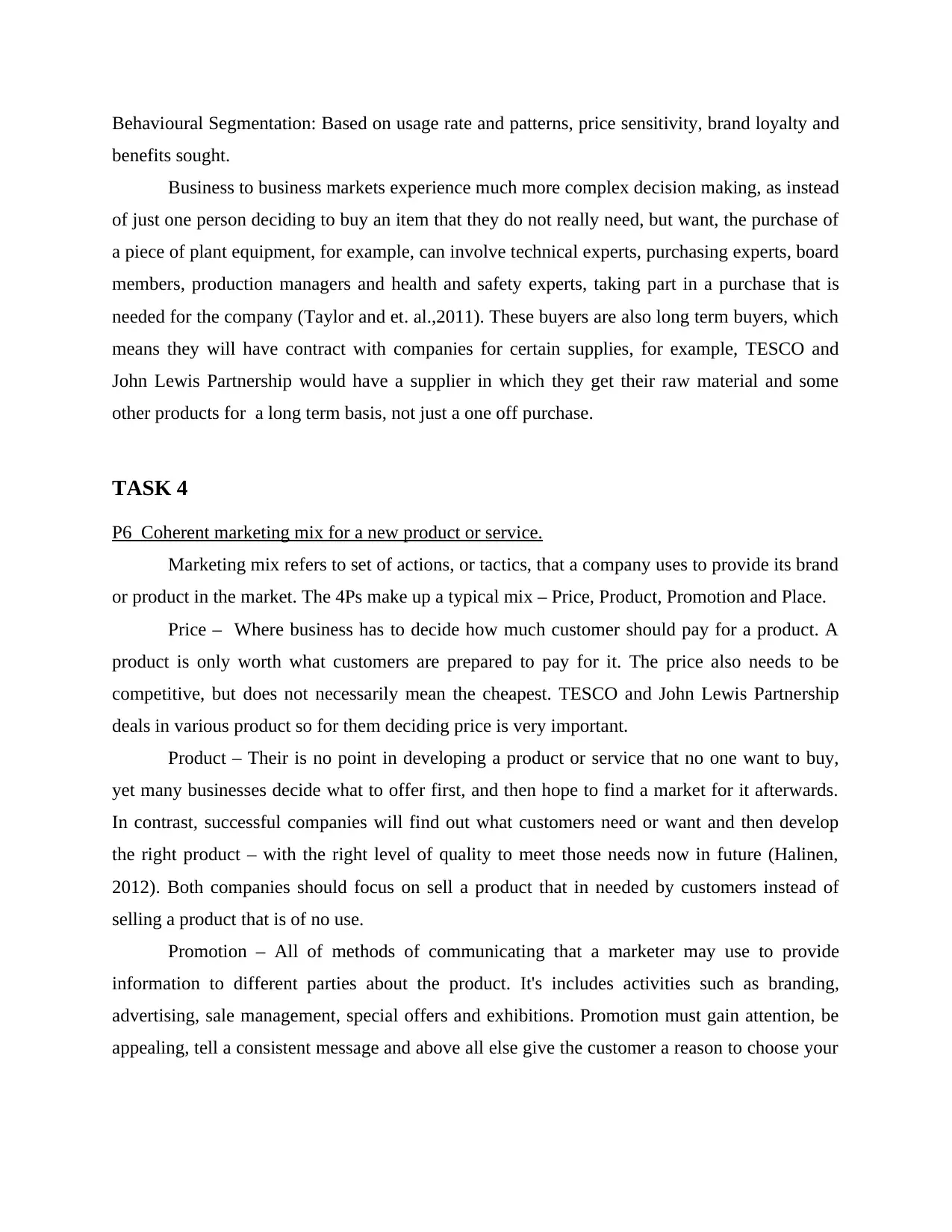
Behavioural Segmentation: Based on usage rate and patterns, price sensitivity, brand loyalty and
benefits sought.
Business to business markets experience much more complex decision making, as instead
of just one person deciding to buy an item that they do not really need, but want, the purchase of
a piece of plant equipment, for example, can involve technical experts, purchasing experts, board
members, production managers and health and safety experts, taking part in a purchase that is
needed for the company (Taylor and et. al.,2011). These buyers are also long term buyers, which
means they will have contract with companies for certain supplies, for example, TESCO and
John Lewis Partnership would have a supplier in which they get their raw material and some
other products for a long term basis, not just a one off purchase.
TASK 4
P6 Coherent marketing mix for a new product or service.
Marketing mix refers to set of actions, or tactics, that a company uses to provide its brand
or product in the market. The 4Ps make up a typical mix – Price, Product, Promotion and Place.
Price – Where business has to decide how much customer should pay for a product. A
product is only worth what customers are prepared to pay for it. The price also needs to be
competitive, but does not necessarily mean the cheapest. TESCO and John Lewis Partnership
deals in various product so for them deciding price is very important.
Product – Their is no point in developing a product or service that no one want to buy,
yet many businesses decide what to offer first, and then hope to find a market for it afterwards.
In contrast, successful companies will find out what customers need or want and then develop
the right product – with the right level of quality to meet those needs now in future (Halinen,
2012). Both companies should focus on sell a product that in needed by customers instead of
selling a product that is of no use.
Promotion – All of methods of communicating that a marketer may use to provide
information to different parties about the product. It's includes activities such as branding,
advertising, sale management, special offers and exhibitions. Promotion must gain attention, be
appealing, tell a consistent message and above all else give the customer a reason to choose your
benefits sought.
Business to business markets experience much more complex decision making, as instead
of just one person deciding to buy an item that they do not really need, but want, the purchase of
a piece of plant equipment, for example, can involve technical experts, purchasing experts, board
members, production managers and health and safety experts, taking part in a purchase that is
needed for the company (Taylor and et. al.,2011). These buyers are also long term buyers, which
means they will have contract with companies for certain supplies, for example, TESCO and
John Lewis Partnership would have a supplier in which they get their raw material and some
other products for a long term basis, not just a one off purchase.
TASK 4
P6 Coherent marketing mix for a new product or service.
Marketing mix refers to set of actions, or tactics, that a company uses to provide its brand
or product in the market. The 4Ps make up a typical mix – Price, Product, Promotion and Place.
Price – Where business has to decide how much customer should pay for a product. A
product is only worth what customers are prepared to pay for it. The price also needs to be
competitive, but does not necessarily mean the cheapest. TESCO and John Lewis Partnership
deals in various product so for them deciding price is very important.
Product – Their is no point in developing a product or service that no one want to buy,
yet many businesses decide what to offer first, and then hope to find a market for it afterwards.
In contrast, successful companies will find out what customers need or want and then develop
the right product – with the right level of quality to meet those needs now in future (Halinen,
2012). Both companies should focus on sell a product that in needed by customers instead of
selling a product that is of no use.
Promotion – All of methods of communicating that a marketer may use to provide
information to different parties about the product. It's includes activities such as branding,
advertising, sale management, special offers and exhibitions. Promotion must gain attention, be
appealing, tell a consistent message and above all else give the customer a reason to choose your
Paraphrase This Document
Need a fresh take? Get an instant paraphrase of this document with our AI Paraphraser
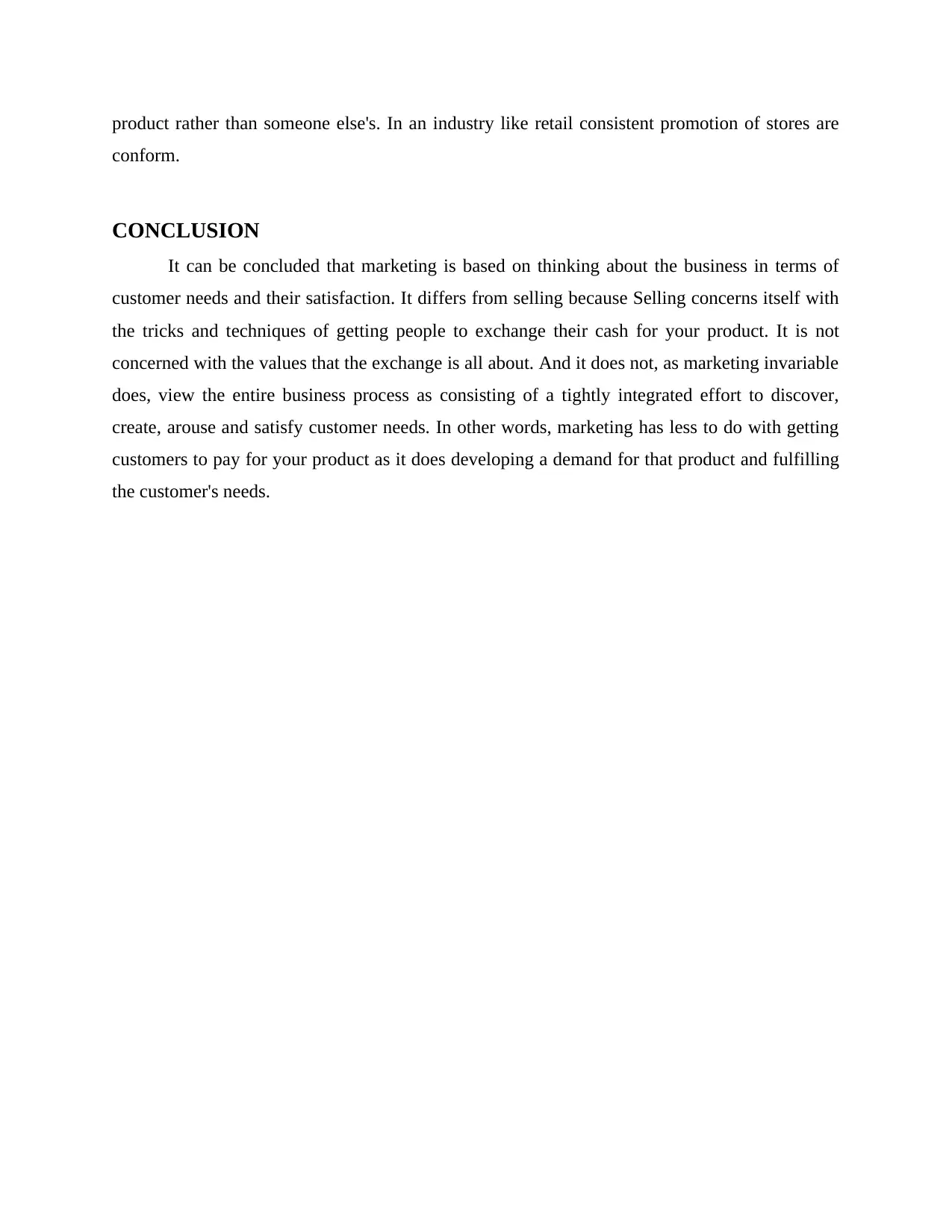
product rather than someone else's. In an industry like retail consistent promotion of stores are
conform.
CONCLUSION
It can be concluded that marketing is based on thinking about the business in terms of
customer needs and their satisfaction. It differs from selling because Selling concerns itself with
the tricks and techniques of getting people to exchange their cash for your product. It is not
concerned with the values that the exchange is all about. And it does not, as marketing invariable
does, view the entire business process as consisting of a tightly integrated effort to discover,
create, arouse and satisfy customer needs. In other words, marketing has less to do with getting
customers to pay for your product as it does developing a demand for that product and fulfilling
the customer's needs.
conform.
CONCLUSION
It can be concluded that marketing is based on thinking about the business in terms of
customer needs and their satisfaction. It differs from selling because Selling concerns itself with
the tricks and techniques of getting people to exchange their cash for your product. It is not
concerned with the values that the exchange is all about. And it does not, as marketing invariable
does, view the entire business process as consisting of a tightly integrated effort to discover,
create, arouse and satisfy customer needs. In other words, marketing has less to do with getting
customers to pay for your product as it does developing a demand for that product and fulfilling
the customer's needs.
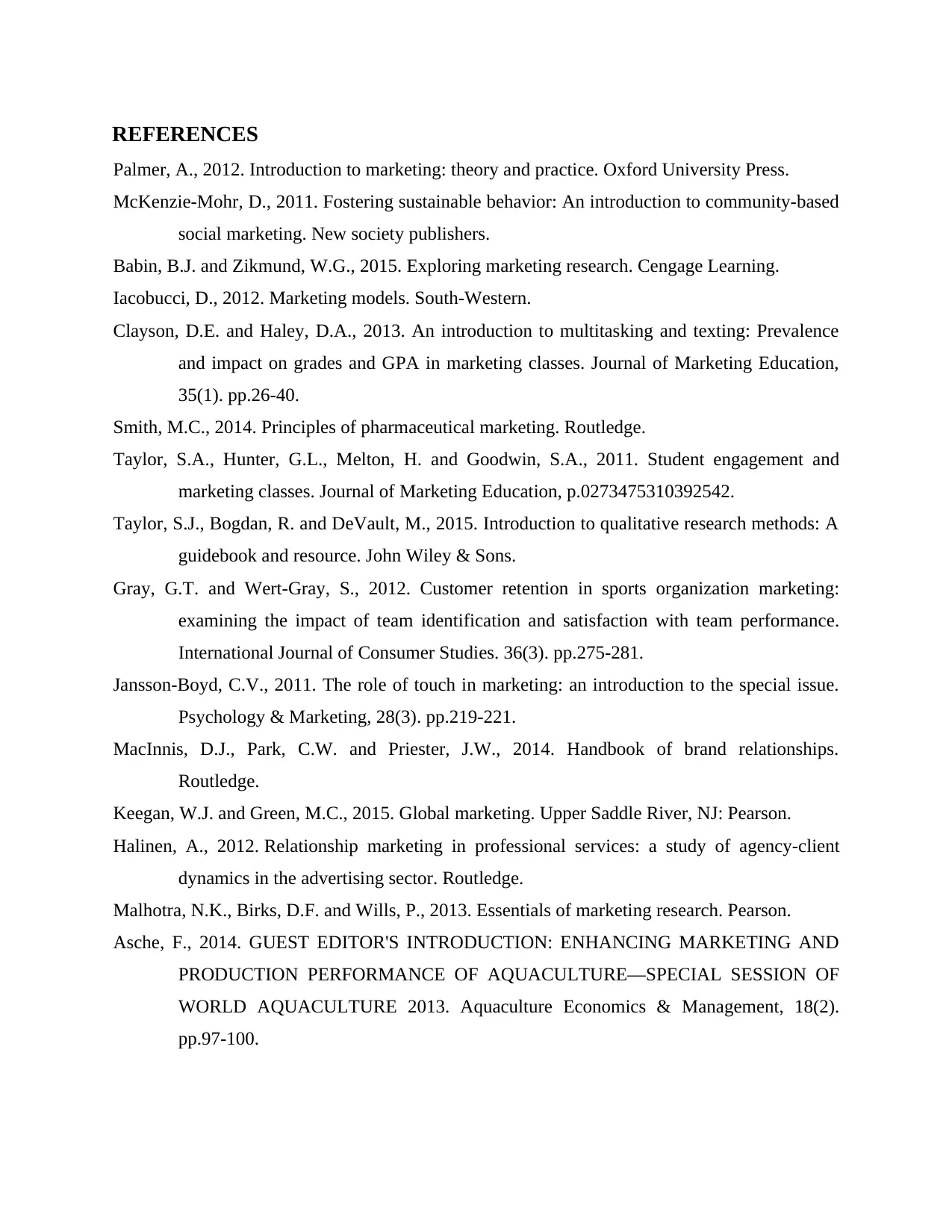
REFERENCES
Palmer, A., 2012. Introduction to marketing: theory and practice. Oxford University Press.
McKenzie-Mohr, D., 2011. Fostering sustainable behavior: An introduction to community-based
social marketing. New society publishers.
Babin, B.J. and Zikmund, W.G., 2015. Exploring marketing research. Cengage Learning.
Iacobucci, D., 2012. Marketing models. South-Western.
Clayson, D.E. and Haley, D.A., 2013. An introduction to multitasking and texting: Prevalence
and impact on grades and GPA in marketing classes. Journal of Marketing Education,
35(1). pp.26-40.
Smith, M.C., 2014. Principles of pharmaceutical marketing. Routledge.
Taylor, S.A., Hunter, G.L., Melton, H. and Goodwin, S.A., 2011. Student engagement and
marketing classes. Journal of Marketing Education, p.0273475310392542.
Taylor, S.J., Bogdan, R. and DeVault, M., 2015. Introduction to qualitative research methods: A
guidebook and resource. John Wiley & Sons.
Gray, G.T. and Wert‐Gray, S., 2012. Customer retention in sports organization marketing:
examining the impact of team identification and satisfaction with team performance.
International Journal of Consumer Studies. 36(3). pp.275-281.
Jansson‐Boyd, C.V., 2011. The role of touch in marketing: an introduction to the special issue.
Psychology & Marketing, 28(3). pp.219-221.
MacInnis, D.J., Park, C.W. and Priester, J.W., 2014. Handbook of brand relationships.
Routledge.
Keegan, W.J. and Green, M.C., 2015. Global marketing. Upper Saddle River, NJ: Pearson.
Halinen, A., 2012. Relationship marketing in professional services: a study of agency-client
dynamics in the advertising sector. Routledge.
Malhotra, N.K., Birks, D.F. and Wills, P., 2013. Essentials of marketing research. Pearson.
Asche, F., 2014. GUEST EDITOR'S INTRODUCTION: ENHANCING MARKETING AND
PRODUCTION PERFORMANCE OF AQUACULTURE—SPECIAL SESSION OF
WORLD AQUACULTURE 2013. Aquaculture Economics & Management, 18(2).
pp.97-100.
Palmer, A., 2012. Introduction to marketing: theory and practice. Oxford University Press.
McKenzie-Mohr, D., 2011. Fostering sustainable behavior: An introduction to community-based
social marketing. New society publishers.
Babin, B.J. and Zikmund, W.G., 2015. Exploring marketing research. Cengage Learning.
Iacobucci, D., 2012. Marketing models. South-Western.
Clayson, D.E. and Haley, D.A., 2013. An introduction to multitasking and texting: Prevalence
and impact on grades and GPA in marketing classes. Journal of Marketing Education,
35(1). pp.26-40.
Smith, M.C., 2014. Principles of pharmaceutical marketing. Routledge.
Taylor, S.A., Hunter, G.L., Melton, H. and Goodwin, S.A., 2011. Student engagement and
marketing classes. Journal of Marketing Education, p.0273475310392542.
Taylor, S.J., Bogdan, R. and DeVault, M., 2015. Introduction to qualitative research methods: A
guidebook and resource. John Wiley & Sons.
Gray, G.T. and Wert‐Gray, S., 2012. Customer retention in sports organization marketing:
examining the impact of team identification and satisfaction with team performance.
International Journal of Consumer Studies. 36(3). pp.275-281.
Jansson‐Boyd, C.V., 2011. The role of touch in marketing: an introduction to the special issue.
Psychology & Marketing, 28(3). pp.219-221.
MacInnis, D.J., Park, C.W. and Priester, J.W., 2014. Handbook of brand relationships.
Routledge.
Keegan, W.J. and Green, M.C., 2015. Global marketing. Upper Saddle River, NJ: Pearson.
Halinen, A., 2012. Relationship marketing in professional services: a study of agency-client
dynamics in the advertising sector. Routledge.
Malhotra, N.K., Birks, D.F. and Wills, P., 2013. Essentials of marketing research. Pearson.
Asche, F., 2014. GUEST EDITOR'S INTRODUCTION: ENHANCING MARKETING AND
PRODUCTION PERFORMANCE OF AQUACULTURE—SPECIAL SESSION OF
WORLD AQUACULTURE 2013. Aquaculture Economics & Management, 18(2).
pp.97-100.
⊘ This is a preview!⊘
Do you want full access?
Subscribe today to unlock all pages.

Trusted by 1+ million students worldwide
1 out of 9
Related Documents
Your All-in-One AI-Powered Toolkit for Academic Success.
+13062052269
info@desklib.com
Available 24*7 on WhatsApp / Email
![[object Object]](/_next/static/media/star-bottom.7253800d.svg)
Unlock your academic potential
Copyright © 2020–2025 A2Z Services. All Rights Reserved. Developed and managed by ZUCOL.





